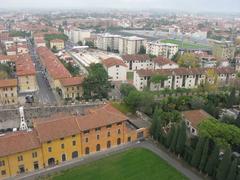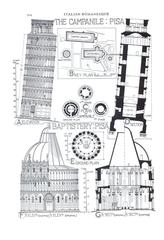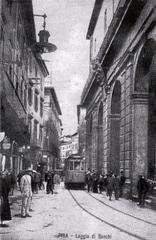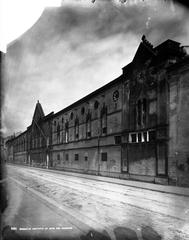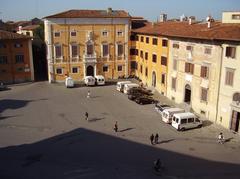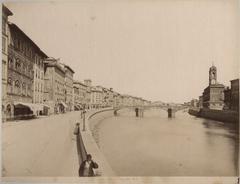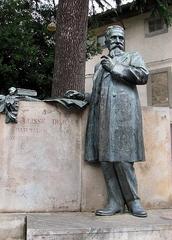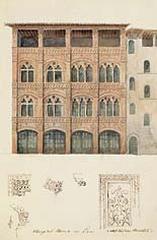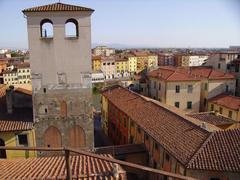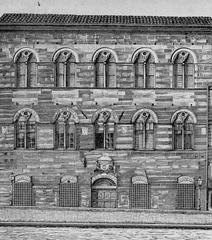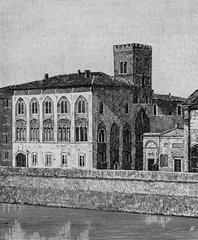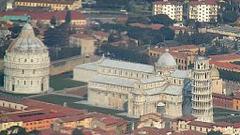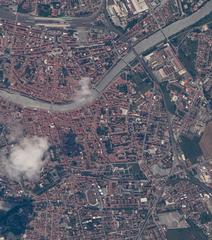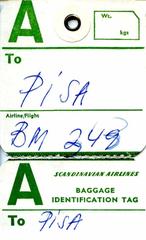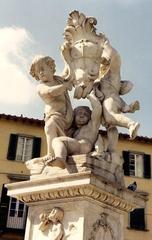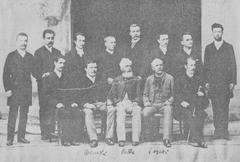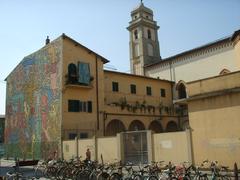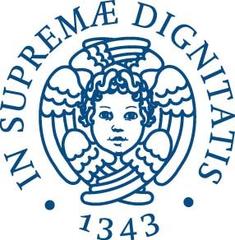
Santa Caterina Pisa: Visiting Hours, Tickets, and Historical Sites Guide
Date: 04/07/2025
Introduction
Nestled in the heart of Pisa, Santa Caterina d’Alessandria is a captivating monument that weaves together centuries of religious devotion, architectural evolution, and artistic achievement. While Pisa is globally recognized for its Leaning Tower, Santa Caterina offers an equally profound glimpse into the city’s medieval spiritual life and the Dominican Order’s lasting influence. Founded in the early 13th century, the church and its former hospital complex reflect Pisa’s transition from Romanesque to Gothic styles and embody a cultural narrative preserved through meticulous restoration (Terre di Pisa; Pisa Tours).
Within its walls, visitors will find masterpieces by leading Tuscan artists, the tomb of Archbishop Saltarelli by Andrea and Nino Pisano, and evocative frescoes that bring sacred themes to life. The church’s single-nave design, renowned for its acoustics, hosts a diverse array of liturgical and cultural events, from concerts to religious ceremonies. Accessibility, a free admission policy, and guided tours make Santa Caterina an inviting destination for all, whether you are an art aficionado, history enthusiast, pilgrim, or casual tourist.
Strategically located near the Piazza dei Miracoli and the Leaning Tower, Santa Caterina serves as both a spiritual sanctuary and a cultural hub in Pisa’s historic center. This detailed guide provides essential information on visiting hours, ticketing, accessibility, and travel tips, while contextualizing Santa Caterina’s historical and artistic significance. Prepare to explore one of Pisa’s most cherished sites and enrich your journey through Tuscany’s heritage.
Table of Contents
- Historical Overview
- Architectural Style and Exterior Features
- Interior Layout and Restoration
- Artistic Heritage and Notable Works
- Practical Visitor Information
- Symbolism and Cultural Significance
- Integration with Pisa’s Urban and Artistic Landscape
- Frequently Asked Questions (FAQ)
- Conclusion and Recommendations
- References
Historical Overview
Origins and Foundation
Santa Caterina d’Alessandria traces its origins to the early 13th century, with the first records in 1211 mentioning both a church and hospital. In 1220, Dominican friar Uguccione Sardo formally established the complex within Pisa’s city walls, reflecting the Dominican Order’s commitment to both spiritual and social care during a period of urban and religious growth.
Architectural Evolution
- Initial Construction and Expansion: The original structure was modest, but from 1251 onwards, the church and hospital expanded, culminating in the completion of the Gothic-style façade in 1326.
- Gothic Features and Artistic Additions: Characterized by pointed arches, a single nave, and side chapels, the church is adorned with notable funerary monuments and altarpieces, including the tomb of Archbishop Saltarelli and works by Lippo Memmi and Aurelio Lomi.
- Restorations and the Orlandi Chapel: After a fire in 1651 destroyed the Orlandi Chapel, extensive restoration followed, including the addition of lateral altars.
Cultural and Religious Significance
Serving as a spiritual center for the Dominican community, Santa Caterina balanced religious functions with social outreach via its hospital. After the 18th-century suppression of religious orders, it became an active parish church, continuing to serve the local community and visitors.
Architectural Style and Exterior Features
Pisan Romanesque and Gothic Fusion
Santa Caterina exemplifies the transition from Pisan Romanesque to early Gothic architecture. Construction began in 1251, blending white Monte Pisano marble with alternating bands of white and grey, reminiscent of the Pisa Cathedral (Wikipedia; gr8traveltips.com; Terre di Pisa). The gabled façade, crowned by a rose window, draws light into the nave and emphasizes the Gothic verticality (Pisa Tours).
Bell Tower and Structural Elements
The bell tower, attributed to Giovanni di Simone, complements the church’s monastic character. The single-nave plan, free of internal columns, creates a vast space ideal for preaching and communal gatherings (Terre di Pisa; La Nazione).
Interior Layout and Restoration
Nave and Spatial Experience
Santa Caterina’s interior is defined by an uninterrupted nave of about 800 square meters. This openness, typical of mendicant orders, maximizes visibility and acoustics for sermons and concerts (La Nazione). The traditional cocciopesto flooring, restored in 2024–2025, echoes the church’s medieval origins.
Acoustics and Liturgical Function
The church’s acoustics make it a favored venue for musical events, with the high, vaulted ceilings resonating beautifully during liturgical ceremonies and concerts (Terre di Pisa).
Artistic Heritage and Notable Works
Tomb of Archbishop Saltarelli
A masterpiece of Gothic funerary art, the tomb of Archbishop Saltarelli was crafted by Andrea and Nino Pisano. It features finely carved figures and intricate motifs, exemplifying 14th-century Pisan sculpture (Pisa Tours).
Altarpieces and Paintings
The church contains works by Lippo Memmi, Fra Bartolomeo, Santi di Tito, Aurelio Lomi, Raffaello Vanni, and Pier Dandini (Pisa Tours). The “Triumph of St. Thomas” altarpiece highlights the legacy of St. Thomas Aquinas, a figure deeply connected with the Dominican Order (Terre di Pisa).
Frescoes and Decorative Elements
Despite losses from a 17th-century fire, surviving frescoes and decorative elements have been preserved and restored, ensuring the church’s artistic legacy endures (Pisa Tours).
Recent Restorations
Recent restorations (2024–2025) revitalized the flooring, pews, and significant artworks, including the “Triumph of St. Thomas” and “Santa Caterina Receives the Stigmata” (La Nazione).
Practical Visitor Information
Visiting Hours
Santa Caterina typically welcomes visitors:
- Monday to Saturday: 9:00 AM – 6:00 PM
- Sunday and public holidays: 12:00 PM – 6:00 PM
Check the official Parish of Santa Caterina website for updates or special closures.
Tickets and Admission
- General Admission: Free
- Guided Tours: May require booking and a fee; inquire in advance through the church or local tourism office.
Accessibility
Santa Caterina is equipped with ramps and assistance for visitors with mobility challenges. Contact the church ahead of your visit for tailored accommodations.
Guided Tours and Special Events
Regular guided tours highlight the church’s art, architecture, and history. Santa Caterina also hosts concerts, religious ceremonies, and community events. Visit Terre di Pisa for an updated events calendar.
Travel Tips and Nearby Attractions
- Combine your visit with the Leaning Tower, Piazza dei Cavalieri, and the Cathedral of Santa Maria Assunta.
- The church is accessible by foot, public transport, or bike. Parcheggio Santa Caterina offers ample parking.
- Modest dress is required; photography without flash is allowed unless restricted during services.
- The area features cafes, restaurants, and shops for a complete day of exploration.
Symbolism and Cultural Significance
Dedication to Saint Catherine of Alexandria
Santa Caterina is dedicated to Saint Catherine, an early Christian martyr revered for her faith and wisdom. The church’s iconography, including the wheel and book, reinforces the values of courage and intellect (Terre di Pisa).
Dominican Heritage
The church’s open design, connection to St. Thomas Aquinas, and collection of Dominican-themed art underscore its monastic roots. Today, the adjacent Istituto Arcivescovile Paritario Santa Caterina continues the tradition of faith-based education (Istituto Santa Caterina).
Integration with Pisa’s Urban and Artistic Landscape
Proximity to Other Landmarks
Santa Caterina stands in harmony with other Romanesque and Gothic monuments, contributing to Pisa’s medieval urban fabric (Turismo Pisa).
Role in Pisa’s Artistic Network
The church remains a vital cultural venue, hosting works by renowned Tuscan artists and serving as a site for music and community events (Terre di Pisa; Pisa Tours).
Frequently Asked Questions (FAQ)
Q: What are the visiting hours of Santa Caterina d’Alessandria?
A: Monday to Saturday, 9:00 AM–6:00 PM; Sunday and holidays, 12:00 PM–6:00 PM. Check official sources for updates.
Q: Is there an entry fee?
A: Entry is free; special tours or events may require tickets.
Q: Are guided tours available?
A: Yes, bookable in advance through the church or local tourism offices.
Q: Is Santa Caterina accessible for people with disabilities?
A: Yes, with ramps and assistance available. Contact in advance for specific needs.
Q: Can I take photographs inside?
A: Photography without flash is generally permitted, except during services or where otherwise indicated.
Q: What are nearby attractions?
A: The Leaning Tower, Piazza dei Cavalieri, and the Cathedral of Santa Maria Assunta.
Conclusion and Recommendations
Santa Caterina d’Alessandria is more than a historic church; it is a vibrant center of worship, culture, and education that embodies Pisa’s medieval spirit and artistic legacy. Its accessible location, free admission, and rich array of art and architecture make it a must-visit for anyone exploring Pisa. Plan ahead, combine your visit with nearby landmarks, and participate in guided tours or cultural events for a truly memorable experience.
For the latest information, updates on visiting hours, and event schedules, consult the Parish of Santa Caterina and Terre di Pisa websites.
Call to Action:
Maximize your trip with the Audiala app for interactive maps, guided tours, and insider tips. Follow us on social media for updates and exclusive content on Santa Caterina and other treasures of Tuscany.
References
- Terre di Pisa – Church of St. Catharine of Alexandria
- Pisa Tour – Church of Santa Catarina
- Rough Guides – Pisa & Around
- Istituto Santa Caterina
- Wikipedia – Santa Caterina, Pisa
- gr8traveltips.com – Pisa Italy
- La Nazione – Santa Caterina Restoration
- Turismo Pisa – Santa Caterina
- Parcheggio Santa Caterina



